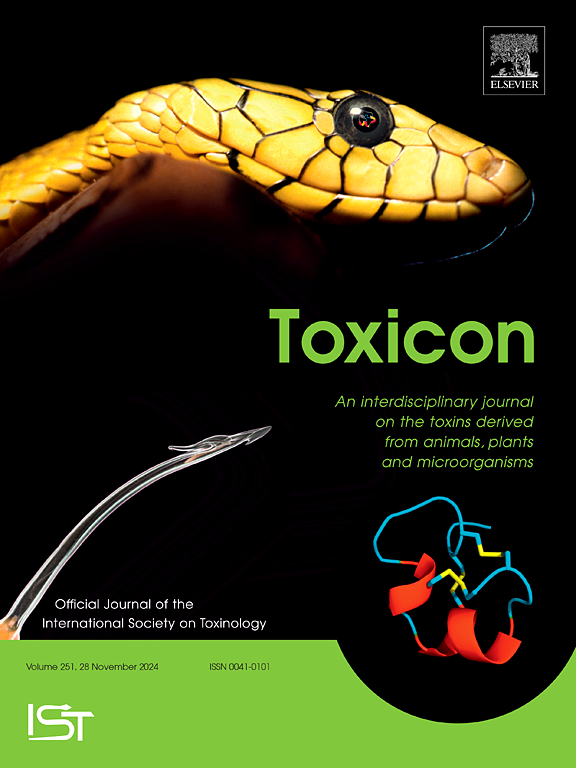In vitro anticoagulant effects of Bungarus venoms on human plasma which are effectively neutralized by the PLA2-inhibitor varespladib
IF 2.6
4区 医学
Q2 PHARMACOLOGY & PHARMACY
引用次数: 0
Abstract
Bungarus (krait) envenomings are well-known for their life-threatening neurotoxic effects. However, their impact on coagulation remains largely unexplored experimentally or clinically. This study, examined the effect of begins to examine venoms from four Bungarus species—B. caeruleus, B. candidus, B. fasciatus, and B. flaviceps on human platelet poor plasma coagulation parameters using thromboelastography and coagulation inhibition assays. B. flaviceps completely inhibited clotting, while B. caeruleus only delayed clot formation. In contrast, B. candidus and B. fasciatus did not affect clotting. Subsequent examinations into the anticoagulant biochemical mechanisms demonstrated divergent pathophysiological pathways. B. caeruleus venom anticoagulant effects were prevented by the addition of an excess of phospholipids, with anticoagulation thereby the result of phospholipid depletion. In contrast B. flaviceps anticoagulation was not affected by the addition of an excess of phospholipids. Further investigations demonstrated that B. flaviceps mediates its anticoagulant toxicity through the inactivation of coagulation enzymes. The anticoagulant effects of both B. flaviceps and B. caeruleus were nullified by varespladib, a phospholipase A2 (PLA2) inhibitor, revealing the toxin class involved. These results uncover previously unrecognized and unexplored anticoagulant effects of Bungarus venoms.

Bungarus 毒液对人体血浆的体外抗凝作用可被 PLA2 抑制剂 varespladib 有效中和。
天牛毒液以其威胁生命的神经毒性作用而闻名。然而,它们对凝血功能的影响在实验和临床上仍未得到广泛探讨。本研究利用血栓弹力图和凝血抑制试验,研究了开始检查四种 Bungarus 物种--B. caeruleus、B. candidus、B. fasciatus 和 B. flaviceps 的毒液对人体血小板差血浆凝血参数的影响。黄蜂属完全抑制了凝血,而草履虫只是延迟了凝血的形成。相比之下,念珠菌和法氏囊菌不影响凝血。随后对抗凝血生化机制的研究显示了不同的生理路径。在加入过量磷脂的情况下,B. caeruleus 毒液的抗凝作用被阻止,因此抗凝作用是磷脂耗竭的结果。与此相反,黄蜂毒液的抗凝作用不受过量磷脂的影响。进一步的研究表明,黄杆菌通过使凝血酶失活来介导其抗凝血毒性。varespladib 是一种磷脂酶 A2(PLA2)抑制剂,它能使黄蜂胆碱酯酶和草履虫胆碱酯酶的抗凝作用失效,从而揭示了所涉及的毒素类别。这些结果揭示了以前未认识和未探索过的Bungarus毒液的抗凝血作用。
本文章由计算机程序翻译,如有差异,请以英文原文为准。
求助全文
约1分钟内获得全文
求助全文
来源期刊

Toxicon
医学-毒理学
CiteScore
4.80
自引率
10.70%
发文量
358
审稿时长
68 days
期刊介绍:
Toxicon has an open access mirror Toxicon: X, sharing the same aims and scope, editorial team, submission system and rigorous peer review. An introductory offer Toxicon: X - full waiver of the Open Access fee.
Toxicon''s "aims and scope" are to publish:
-articles containing the results of original research on problems related to toxins derived from animals, plants and microorganisms
-papers on novel findings related to the chemical, pharmacological, toxicological, and immunological properties of natural toxins
-molecular biological studies of toxins and other genes from poisonous and venomous organisms that advance understanding of the role or function of toxins
-clinical observations on poisoning and envenoming where a new therapeutic principle has been proposed or a decidedly superior clinical result has been obtained.
-material on the use of toxins as tools in studying biological processes and material on subjects related to venom and antivenom problems.
-articles on the translational application of toxins, for example as drugs and insecticides
-epidemiological studies on envenoming or poisoning, so long as they highlight a previously unrecognised medical problem or provide insight into the prevention or medical treatment of envenoming or poisoning. Retrospective surveys of hospital records, especially those lacking species identification, will not be considered for publication. Properly designed prospective community-based surveys are strongly encouraged.
-articles describing well-known activities of venoms, such as antibacterial, anticancer, and analgesic activities of arachnid venoms, without any attempt to define the mechanism of action or purify the active component, will not be considered for publication in Toxicon.
-review articles on problems related to toxinology.
To encourage the exchange of ideas, sections of the journal may be devoted to Short Communications, Letters to the Editor and activities of the affiliated societies.
 求助内容:
求助内容: 应助结果提醒方式:
应助结果提醒方式:


